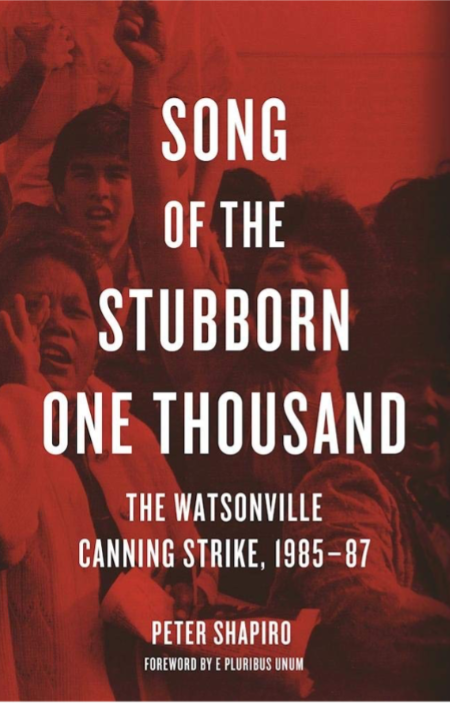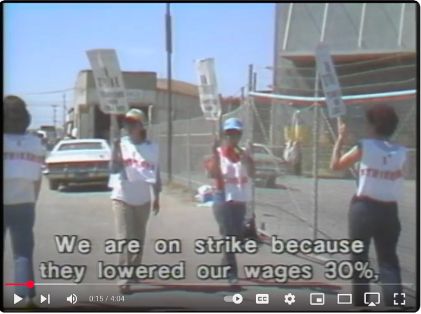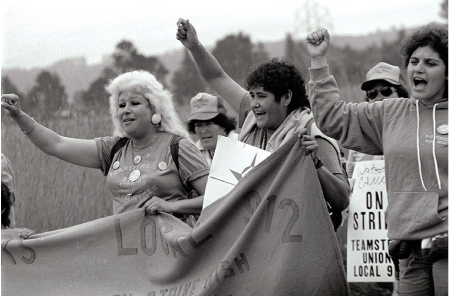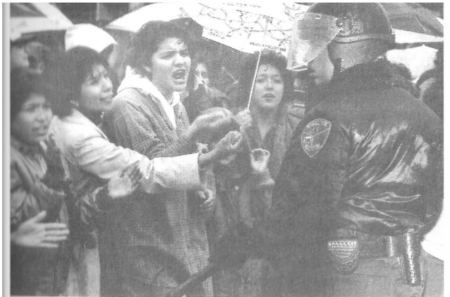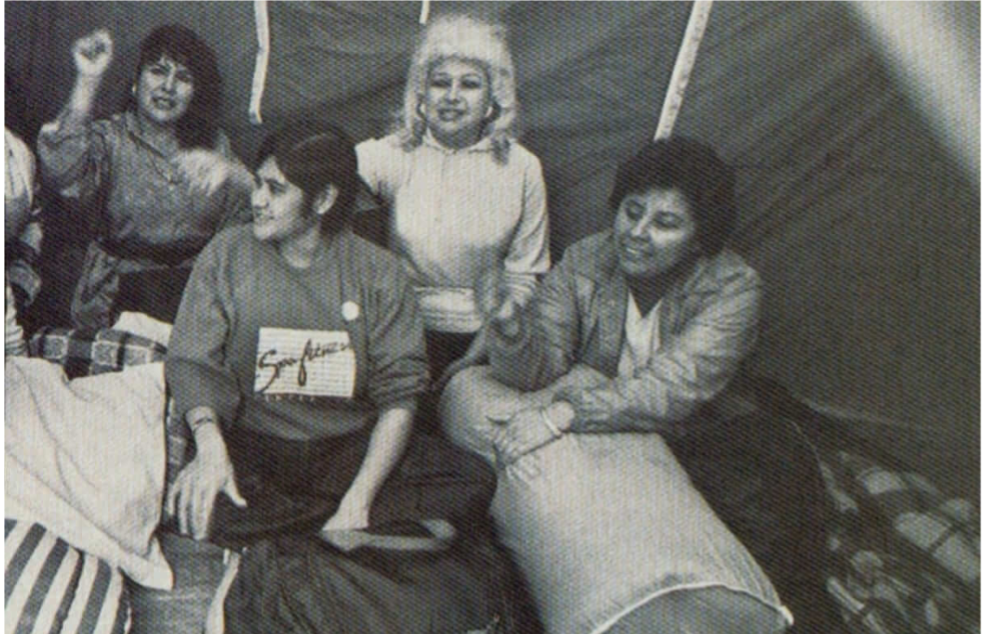|
|
The weekly newsletter of the Mexico Solidarity Project |
|
Every issue archived online at mexicosolidarityproject.org/archives/ |
|
July 30, 2025 |
|
|
|
Song of the Stubborn One Thousand |
|
Peter Shapiro and Agatha Hinman, for the editorial team |
|
|
Watsonville Cannery Strike: Photo and digitization provided by Pajaro Valley Historical Association |
|
President Ronald Reagan in the 1980s ushered in a frontal attack on labor. It was an era of outright union busting and lost strikes. But the story of the one thousand mainly Mexicana workers of Watsonville Canning, the largest plant in what was then the “frozen food capital of the world,” had a surprisingly different ending.
When I got involved in the Watsonville strike, I was editing the labor section for Unity newspaper, published by the now-defunct socialist organization, the League of Revolutionary Struggle. The League had organized a statewide cannery workers network, and Watsonville’s Teamsters for a Democratic Union chapter affiliated with it. Several League organizers were on the scene and developed close ties with the strikers, so I got on-the-spot reports and went down to Watsonville for the big support rallies.
It was a long shot that low-paid women workers, some of whom were Spanish-speaking only, could win a strike. The media ignored it, uninterested or unconcerned about the fate of Mexican women workers. I was happy to at least be covering it for our newspaper. Their story stayed in the back of my mind, and I knew its lessons were important for the labor movement to hear.
Thirty years later I finally got a chance to write about it in depth. It wasn’t until researching my book Song of the Stubborn One Thousand and interviewing the strikers that I began to truly appreciate what the strikers had to do to win. The hardships they endured, the difficult choices they had to make, the incredible strength they demonstrated — they were just too stubborn to lose. |
|
|
The Strike that Changed Watsonville |
|
|
Peter Shapiro is the author of Song of the Stubborn One Thousand: The Watsonville Canning Strike, 1985-87, published by by Haymarket Books. As a long-time labor activist, Peter was a union officer in the Portland-based National Association of Letter Carriers from 2002-2008 and currently serves as a delegate to the Alameda Labor Council. |
|
|
What precipitated the Watsonville Canning Strike?
It was an industry problem. By the early 80s, the frozen food industry suffered from overcapacity. Watsonville Canning’s owner decided he could get a leg up on the competition by driving the union out of his plant. He hired a union-busting law firm, got an $18 million line of credit from Wells Fargo Bank and demanded a 40% pay cut from workers. That did it. They struck! |
|
He planned to run the plant with scabs for 12 months and then petition the National Labor Relations Board for a decertification election, because after 12 months, only the scabs would be entitled to vote. Outrageous as it sounds, many employers used that strategy in the 80s. |
|
|
Watsonville On Strike - excerpt, Migrant Media Productions – Jon Silver |
|
These workers were overwhelmingly Mexican women. In one village in the state of Jalisco, 80% of the villagers had relatives in Watsonville. For example, Gloria Betancourt, a rank-and-file strike leader, came to Watsonville in her early teens. Her father, a bracero, was able to get citizenship and send for his family. But years of hard labor in the fields had affected his health, so Gloria lied about her age and got hired at Watsonville Canning, the oldest and largest of the local frozen food plants. I asked her how she got away with it. She said, “You just slap a little makeup on your face, it makes you look older.” |
|
The frozen food industry was still new and had expanded rapidly in the 50s and 60s. The pay was better and the work was steadier than farm labor — no traveling around following the harvests. Workers even had union-negotiated health benefits, which was a big deal. |
|
|
Watsonville Strikers Holding a Banner. Unity Archive Project. Labor Archives and Research Center Special Collections Gallery, J. Paul Leonard Library, fourth floor |
|
What role did the Teamsters Union play?
A tough old merchant seaman with a fondness for booze ran the Teamsters local in Watsonville. He didn’t speak a word of Spanish and ran the local with what’s called “the padrone system” — “I take care of my people, no need for anyone else to get involved.” The union contract covered all the town’s frozen food plants. He drank with all the plant owners, and, while the industry was expanding, he got pretty good contracts from them. But one owner broke ranks, and the whole thing fell apart. He went off on a binge and then flat-out quit.
The Watsonville Canning workers were mistrustful of the union. As members, they were more or less invisible. Margarita Paramo, one of the strikers, said they were expected to just "pay our dues and be happy." When the strike began, the union was barely functioning, and the strikers pretty much had to run the strike themselves.
But the Teamsters higher-ups knew that losing this strike would drive them out of the industry, so they were willing to spend money to win. Aside from strike benefits and legal fees, they put $20,000 a month into an economic sanctions campaign against the owner. They hoped to force the owner out of business by negotiating quick settlements with his competitors, even though it meant making concessions that would also apply to the Watsonville strikers. |
|
|
Strikers confront the police at the gates of the Watsonville Canning plant (1986). Holger Leue/Unity. |
|
The Teamsters needed the strikers too. Ten months into the strike, they realized that if the strikers petitioned for a labor board election before the twelve months were up, they could vote along with the scabs and maybe prevent the union from getting decertified. Winning the vote required a close to 100% turnout. |
|
But the strikers had scattered. Some had been evicted and were living in cars or doubling up with other strikers. Some had left town to follow the harvests and earn enough to tide them over. Several dozen went back to Mexico to wait out the strike.
Yet every one of them came back to town for the day of the vote. And the Teamsters won!
That was the strike’s turning point. The strikers made it happen, and the Teamsters knew it.
One thousand workers went out for 18 months, and not one person crossed the picket line. What was responsible for that amazing mass commitment? |
|
They took care of each other the way you do for family — some were family. The women were uncomfortable in the union hall because the men resented their presence, so they met in each other’s homes to talk strike strategy. The rank-and-file strike committee kept tabs on strikers who left town. |
|
|
“Women are the backbone of this strike,” says strike leader Gloria Betancourt (above, second from right). Photo credit: Kurt Rogers, San Francisco Examiner. |
|
If someone’s kid needed watching, or if someone was pregnant or having trouble with her husband, her fellow strikers were there for her. Everyone knew everyone else’s business. No one thought about scabbing. If they did, they knew they’d have to face their neighbors.
And they were tough. Gloria Betancourt said, “Just because you’re Catholic doesn’t mean you can’t throw rocks at scabs!”
Maybe it helped that the strikers had to organize themselves independently from the union — an enormous responsibility but a shared one, forcing them to rely on each other. Even before the strike, they faced race and gender discrimination on and off the job and confronted it together. They called themselves “stubborn Mexican women.”
How did the strike end?
The owner owed a $5 million debt for broccoli to a local grower who knew that, with the company in foreclosure, he was unlikely to get his money back. He realized the only option for him was to buy the plant, settle with the union, hire back the strikers, operate it at a profit and recoup his losses. Unlike the old owner, he knew he needed experienced workers to make it pay.
Against all odds, these thousand Mexican women workers won!
How did the strike affect the Mexican community in Watsonville?
When the strike broke out, Mexicans were close to a majority in Watsonville but largely invisible. During the strike, the workers went to the City Council to protest police action against them, but the chair refused to allow Spanish translation, saying it would waste the council’s time. |
|
|
Watsonville cannery striker Paula Hernandez with her son, Fourth District County Supervisor Felipe Hernandez. Credit: Kevin Painchaud / Lookout Santa Cruz |
|
|
Cannery striker Sylvia Baltazar visits with her daughters Blanca and Wendy in Jon Silver’s “Daughters of the Strike.” Credit: Jon Silver |
|
The struggle to be heard started at their workplace, but these women didn’t stop there. After the strike, a successful voting rights lawsuit resulted in district elections, and the workers were able to elect allies to the City Council. City business was conducted in Spanish and English. As for the Teamsters, former strikers were elected to union office, and the local was rejuvenated. The women, their families, their union and Watsonville were forever changed. |
|
|
|
|
Defending the Sovereignty of Venezuela |
|
|
Mexico City based freelance writer and photojournalist José Luis Granados Ceja previously spent time as a staff writer for teleSUR, and currently works with Venezuelanalysis. His writing on contemporary Latin American democratic struggles can be followed on X (Twitter): @GranadosCeja. |
|
|
This month, after suffering months of systematic torture, indiscriminate beatings, sexual assault and medical neglect, over 252 Venezuelans unlawfully detained by the United States and sent to El Salvador’s notorious CECOT prison were finally freed thanks to the efforts of the Nicolás Maduro government.
The arrest and forced expulsion of the men from the US prompted lawsuits and protests inside both Venezuela and the US demanding their liberation. Also, protesting US lawmakers visited El Salvador, and, inside the Oval Office, a showdown with the press featured Salvadoran President Nayib Bukele and US President Donald Trump.
In the end, neither the Democrats nor the US justice system secured the prisoners’ release from Nayib Bukele’s hell on Earth. It was the Maduro government, among the most vilified on the planet, who promised they’d find a way to free their people and they did.
Ultimately, the deal released the migrants who were flown to Venezuela in exchange for 10 US citizens and permanent residents in Venezuelan custody. Much of the bourgeois press, such as the New York Times, ever serving US imperialism, attempted to deny the incontrovertible fact that this was a massive diplomatic win for the besieged Venezuelan government.
Instead, authors Julie Turkewitz and Hamed Aleaziz claimed that Maduro was systematically “detaining and imprisoning foreigners late last year” to be used as “bargaining chips.” Never mind that those released for exchange by Venezuela had been detained based on serious allegations of illegal activity, such as involvement in destabilization plots. One prisoner was Dahud Hanid Ortiz, who confessed that he was behind the violent murder of three people in Madrid in 2016 and was awaiting extradition to Spain.
The release of the migrants from CECOT is a testament to the implacable, adamant and obdurate defense of Venezuela sovereignty by the government and its people. If Maduro can be said to have wielded any bargaining chips in this negotiation, it was his government’s proven track record of never yielding to US bullying.
Venezuelans have, of course, paid a heavy price for their dogged defense of their right to determine their own political and economic model, but their dignity has remained intact.
The important lesson for Latin America is that playing nice with US imperialism only gets you so far. Washington will always throw its weight around; the bully will never be satisfied. As Mexico wrestles with an intemperate neighbor, the Claudia Sheinbaum government would be wise to learn from Venezuela’s experience in standing up to the US.
From tariffs to border closures and even efforts at controlling Mexican airspace, the Trump administration is deadset on squeezing Mexico in every way. Sheinbaum’s crafty negotiating has pulled Mexico back from the brink of a diplomatic disaster on several occasions but the status quo is untenable.
With Mexico hawks in the White House salivating at the notion of a direct attack inside Mexican territory, Sheinbaum must prepare now for a possible direct confrontation with US imperialism. The Bolivarian Revolution in Venezuela has shown time and time again the importance of understanding your enemy. |
|
|
|
Recent news reports and commentaries, from progressive and mainstream media, |
|
James Wagner, Removal of Castro and Guevara Statues Ignites Outcry in Mexico City New York Times. The Cuban Revolution leaders joined forces in Mexico in 1955. A local mayor removed a memorial to them, drawing protests and condemnation from Mexico’s highest office.
Lizeth Coello, Armas de guerra israelíes caen en manos de los cárteles mexicanos HispanTV. Activistas señalan que es preocupante que las armas con las que cuenta el crimen organizado aumentaron exponencialmente, y preocupante aún más que son provenientes de Israel, con un rol genocida que ahora juega en Palestina desde el reinicio de las hostilidades el pasado 7 de octubre de 2023.
Javier Porras Madero, Yon Sosa: History of MR-13 in Guatemala & Mexico NACLA. Arturo Taracena’s deep dive into the Guatemalan guerrilla group and its leader, informed by personal experience and decades of research, is social history at its finest.
Sabina Berman, Morena no se atreve El Universal. Yo me quedo solo observando cómo la indecisión retrasa la ruptura de Morena con los usos y costumbres de la política mexicana, siempre corrupta.
Christy Thornton, Revolutionary Mexico Tried to Transform the World Economy Jacobin. [From 2021] In the twentieth century, the post-revolutionary Mexican government drew up ambitious plans to transform the world economic system for the benefit of the Global South. Their failure helped turn Mexico itself into a laboratory for neoliberalism.
Miguel Flores, Luisa María Alcalde asegura que “no hay intocables” en Morena ante señalamientos contra Adán Augusto López Infobae. En Coahuila, Luisa María Alcalde descartó impunidad en casos de corrupción y crimen organizado.
Tariffs, trade and trust building: solidarity with our union allies in Mexico United Steelworkers Canada. The SHF has a long-term relationship of solidarity with our union brothers and sisters in Mexico, especially through the Mineros union and the Authentic Labour Front (FAT)
Andrea Becerril y Fernando Camacho, Escándalos de Adán Augusto y Monreal le pegan a la 4T La Jornada. Los coordinadores de Morena en ambas cámaras han alimentado las críticas de la oposición y mediáticas.
Sheinbaum Demands Immediate Repatriation of Mexicans Held at Alligator Alcatraz Telesur English. Mexican consulates in the U.S. are investigating whether human rights violations have occurred inside the Alligator Alcatraz facility, where 14 nationals are being held.
Claudia recibe a Johnson Sin Embargo. Esta es la tercera visita que el Embajador de Estados Unidos realiza a Palacio Nacional desde que recibió sus cartas credenciales en el país el pasado 19 de mayo. |
|
|
|
|
The Mexico Solidarity Project brings together activists from various socialist and left organizations and individuals committed to worker and global justice. We see the 2018 election of Andrés Manuel López Obrador as president of Mexico as a watershed moment. AMLO and his progressive Morena party aim to end generations of corruption, impoverishment, and subservience to US interests. Our Project supports not just Morena, but all Mexicans struggling for basic rights, and opposes US efforts to undermine organizing and Mexico’s national sovereignty.
Editorial committee: Meizhu Lui, Bruce Hobson, Agatha Hinman, Victoria Hamlin, Courtney Childs, Pedro Gellert. To give feedback or get involved yourself, please email us! |
|
Subscribe! Get the Mexico Solidarity Bulletin in your email box every week. |
|
Web page and application support for the Mexico Solidarity Project from NOVA Web Development, a democratically run, worker-owned and operated cooperative focused on developing free software tools for progressive organizations. |




